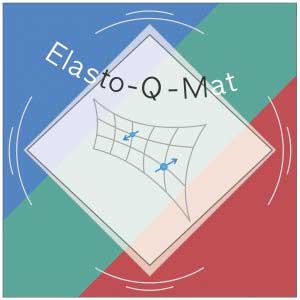| Jun 23, 2020 | |
New quantum materials with unique properties(Nanowerk News) Karlsruhe Institute of Technology (KIT) is partner of the new Collaborative Research Center/Transregio (CRC/TRR) project “Elastic Tuning and Elastic Response of Electronic Quantum Phases of Matter” (ELASTO-Q-MAT). |
|
| This project focuses on quantum materials, whose properties can be modified significantly by elastic deformation. The project is coordinated by the University of Frankfurt/Main. Spokesperson of KIT is Professor Jörg Schmalian. The project will be funded by the German Research Foundation (DFG) with about EUR 10 million in the next four years. | |
 |
|
| ELASTO-Q-MAT focuses on quantum materials, whose properties can be modified significantly by elastic deformation. (Image: CRC/TRR 288) | |
| “I congratulate the scientists involved on this appreciation of their thrilling research concept and look forward to the results of their work,” says Professor Oliver Kraft, KIT Vice-President for Research. | |
| The CRC/TRR 288 ELASTO-Q-MAT will focus on novel physical phenomena of solids resulting from a particularly strong coupling between a material’s elastic properties and its electronic quantum phases. | |
| Based on the findings obtained, the researchers will produce new quantum materials with extraordinary properties and open up the application potential resulting from interactions between mechanical and electronic properties. | |
| Physical properties of quantum materials can only be explained by quantum theory, an example being superconductivity, i.e. disappearance of electrical resistance below a critical temperature, the so-called transition temperature. | |
| “Quantum materials with easily adjustable electronic properties are the key to future quantum technologies,” says Professor Jörg Schmalian, Head of the Institute for Theoretical Condensed Matter Physics (TKM) of KIT, Topic Spokesperson at the KIT Center Materials in Technical and Life Sciences, and Co-spokesperson of the new ELASTO-Q-MAT CRC/TRR. | |
| Many materials respond to mechanical deformation by changing their electronic or magnetic properties. For instance, mechanically induced doubling of transition temperatures occurs in certain oxides or novel charge orders develop in high-temperature superconductors. Some materials exhibit a unique superelasticity with reproducible strains of nearly 20 percent. | |
| “To tackle central questions of future quantum technologies, we can and have to combine smart experimental tricks with elegant quantum field theory,” Schmalian explains. |
| Source: Karlsruhe Institute of Technology | |
|
Subscribe to a free copy of one of our daily Nanowerk Newsletter Email Digests with a compilation of all of the day's news. |
